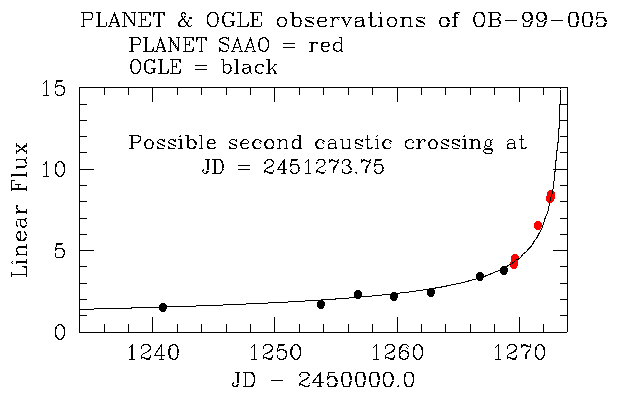
Both the most recent PLANET collaboration data and publicly available OGLE team data indicate that the microlensing event OGLE 99-BLG-005 peaked at JD = 2451275.20 (+/- 0.16) and is now falling. This peak time corresponds to about 17:00 April 6 UT. The OGLE team has quickly reanalyzed their data using a differential method and made available the new light curve that shows none of the irregularities that were seen previously. The new OGLE light curve together with previous and on-going PLANET photometry indicate that OGLE 99-BLG-005 is a normal single lens event, though of very high magnification. At peak it may have been as much as 29 times brighter than normal. Any remaining asymmetries in the light curve are not of the type expected for caustic crossings.
Caustic crossing events can be used to measure source resolution effects, which can allow the determination of the relative proper motion of the lens and, in special circumstances, the limb-darkening of the source star. High magnification events, like OGLE 99-BLG-005, are especially likely to betray the presence of possible planets orbiting the lens. Data continues to be taken by the PLANET team in an attempt to discover or constrain the types of planets that may be orbiting the lens of OGLE 99-BLG-005.
OGLE announced their discovery of OGLE 99-BLG-005 on 25 March 1999 and noted at that time that it may be a high magnification event.
Event: OB-99-005
RA (J2000): 17:47:24.05
Dec (J2000): -34:46:21.5
The baseline I magnitude now reported by the OGLE team is 18.796.
On 4 April 1999, the PLANET collaboration reported that the apparent brightness of OGLE~99-BLG-005 was rising very steeply. Combined fits to the PLANET collaboration data and public OGLE data available at that time indicated that OGLE-99-BLG-005 was either a high magnification and would peak in the next 4 (+/- 3) days or was a caustic crossing event about to undergo a (second) caustic crossing near JD = 2451273.75. (If this event were indeed inside a caustic contour on 4 April and about to undergo a second crossing, it would need to be blended with another star to be consistent with theoretical expectations.) PLANET announced this in an initial electronic anomaly alert.
The plot below, showing brightness as a function of time (in days), illustrates how the initial data indicated that OGLE 99-BLG-005 might be approaching a (second) caustic crossing.

| ABOVE: OGLE (black dots) and PLANET SAAO (red dots) data in the I band filter shown with a CAUSTIC model (line). Flux scale is linear. |
Although the rise in brightness PLANET data prior to 6/7 April was consistent with single-lens models, PLANET and OGLE data on that night appeared to show an asymmetry, suggested that the light curve may instead be consistent with the background source being resolved by caustic structure generated by a multiple lens. This was announced in a subsequent PLANET alert update. The behavior of the light curve was not well understood however, and both PLANET and OGLE re-examined their data. Recent data and a re-analysis of older data now confirm the single-lens high magnification model as consistent with the data and rule out a caustic crossing during the first week of April 1999.
Finding charts and updated information can be found on the PLANET web site at http://planet.iap.fr.
OGLE information on this and other events can be found at the OGLE alert web page at: http://www.astrouw.edu.pl/~ftp/ogle/ogle2/ews/ews.html.